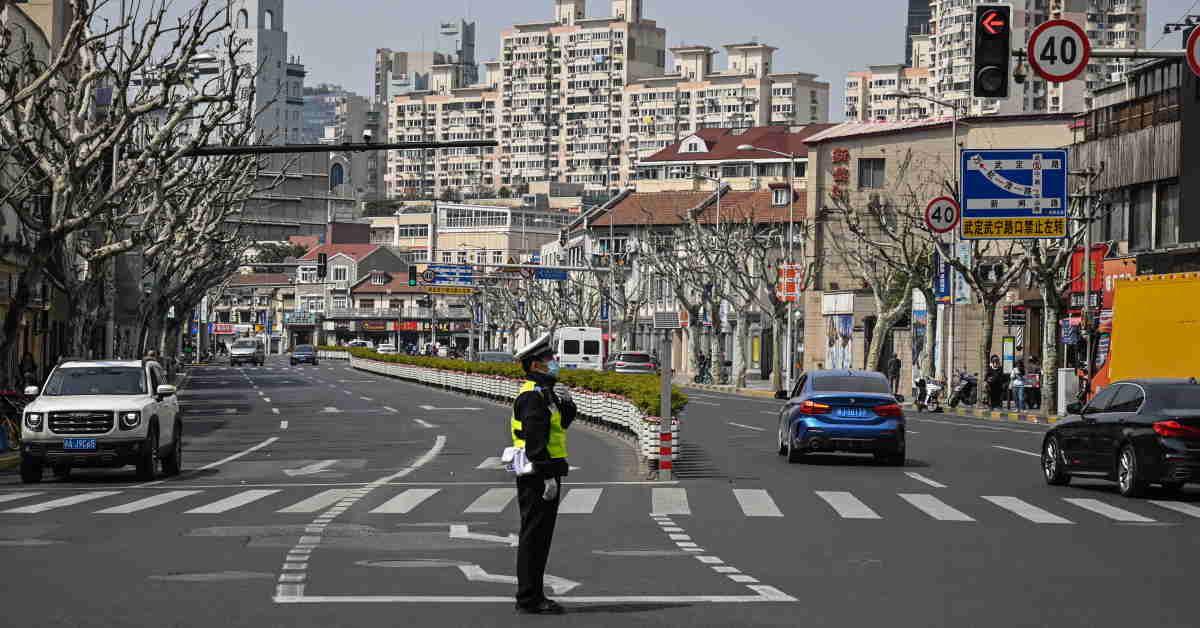In Pyongyang, COVID is spreading fast, and one capital where the North Korean disaster is surely being watched with rapt attention is Beijing. North Korea, like China, has made a virtue of its authoritarian system being better suited to COVID control than the democracies.
Unlike North Korea, China has been rolling out vaccines for more than a year, but like its neighbour, it has millions of older people who have never taken the jab. China’s leaders can see in their neighbours a COVID situation that they fear could be their fate if the virus takes hold and they have responded with a lockdown in the mega-city of Shanghai that has lasted seven weeks and shows no immediate signs of ending.
As locals stay confined to their homes, drones fly near apartment blocks, intoning the phrase: “Control your soul’s desire for freedom.” China can still argue that in absolute terms its “zero-COVID” policy has had remarkable success in preventing deaths.
Last week, Joe Biden mourned the grim toll of a million American deaths from the disease, whereas China’s official figures suggest only 5,000 deaths in a population four times the size. Even if one assumes that the real figure is several times higher, it is still a remarkable achievement.
But it has come at a price; there is no clear policy for how China can reopen its borders to live with a virus that scientists expect to become endemic, or how to deal with it, other than with repeated lockdowns that harm the fragile economy and have led to increased panic as whole households are taken to quarantine because one case has been detected in an apartment block.
That reopening is unlikely to happen in 2022. One of the main reasons for keeping China’s doors closed is the need for a smooth ride toward the 20th party congress, which is likely to be in October, where Xi Jinping is set to be chosen for an unprecedented third term as China’s leader. The zero-COVID policy, in which the virus is to be eliminated from China, is personally associated with Xi and it would be immensely difficult to change the narrative before the congress.
Therefore, other ways of explaining the lockdown have taken hold. One is the story that China’s system allows a more efficient, if controversial, deployment of mass mobilisation combined with high-quality science. Social media has been filled with discussions of the “dabai”, literally “big whites”, health enforcement workers, dressed head to toe in white PVC personal protective equipment (PPE), who spray disinfectant in suspect households and who have the power to compel people into quarantine. For some, they are symbols of a futuristic modernity.
Their critics say that they represent the faceless power of the authoritarian state that allows no appeal. However, the online discussion misses a key point: the dabai are just ordinary officials and workers. By deflecting attention to the harsh tactics of workers on the ground, the public is distracted from discussing the national-level policy (a discussion that censorship mostly prevents).
Meanwhile, China continues to search for one possible solution to the long cycle of lockdowns: an effective Chinese mRNA vaccine that mimics the working of the highly effective Pfizer and Moderna jabs. China’s national pride means that it won’t import the western vaccines but, despite huge amounts of investment from state and private sector, its own labs have not yet come up with a Chinese equivalent.
Several private sector pharmaceutical companies are reported to have mRNA vaccines in the test stage, but even when they are approved by the regulators, there still needs to be a national rollout and much more effort to get the elderly to take the vaccine. That points to a programme that could last well into 2023, if not longer.
Meanwhile, the lockdowns are grinding down the economy, not just in Shanghai, but nationwide. The prime minister, Li Keqiang, said last week that China’s economic outlook was “complicated” and “grim”. Hu Chunhua, a vice-premier who some are tipping to move to a top seat on the elite standing committee of the politburo, has hinted that labour unrest is a real possibility and advocated stronger state support for groups in danger of unemployment.
The danger of protest is real: during the privatisations of the 1990s, demonstrations in rustbelt cities such as Shenyang in the north-east showed popular feeling rising high as people realised their old factory jobs were doomed. The new generation of workers don’t expect jobs for life, but they do expect a predictable economic playing field, particularly if they work in China’s dynamic private sector. COVID has turned that predictability upside down.
In the short term, in a year of significant domestic politics and turbulent economics, there are some advantages to keeping the doors shut. China isn’t dependent on tourism or foreign student numbers, it has very low immigration levels and it needs relatively few overseas executives to keep even its internationally oriented businesses going. Sectors that a few years ago would have needed significant input from outside, such as technology, are rapidly becoming indigenised.
Yet a return to the days of chairman Mao’s Cultural Revolution, when China really was closed to the outside world, is unthinkable in the longer term. China needs to export and import, something hard to do while ports such as Shanghai are in near shutdown.
More broadly, China has always done best when it has been most open to ideas and influences from the wider world. In the 1920s, Shanghai was the crucible of Chinese modernity, as its sophisticated young people drank French coffee, read Russian novels and dreamed of studying in America.
It would be a bitter irony if the 2020s saw the same great cosmopolitan city forced to retreat in the face of an irrepressible virus, with the vibe not of Paris but of Pyongyang.
